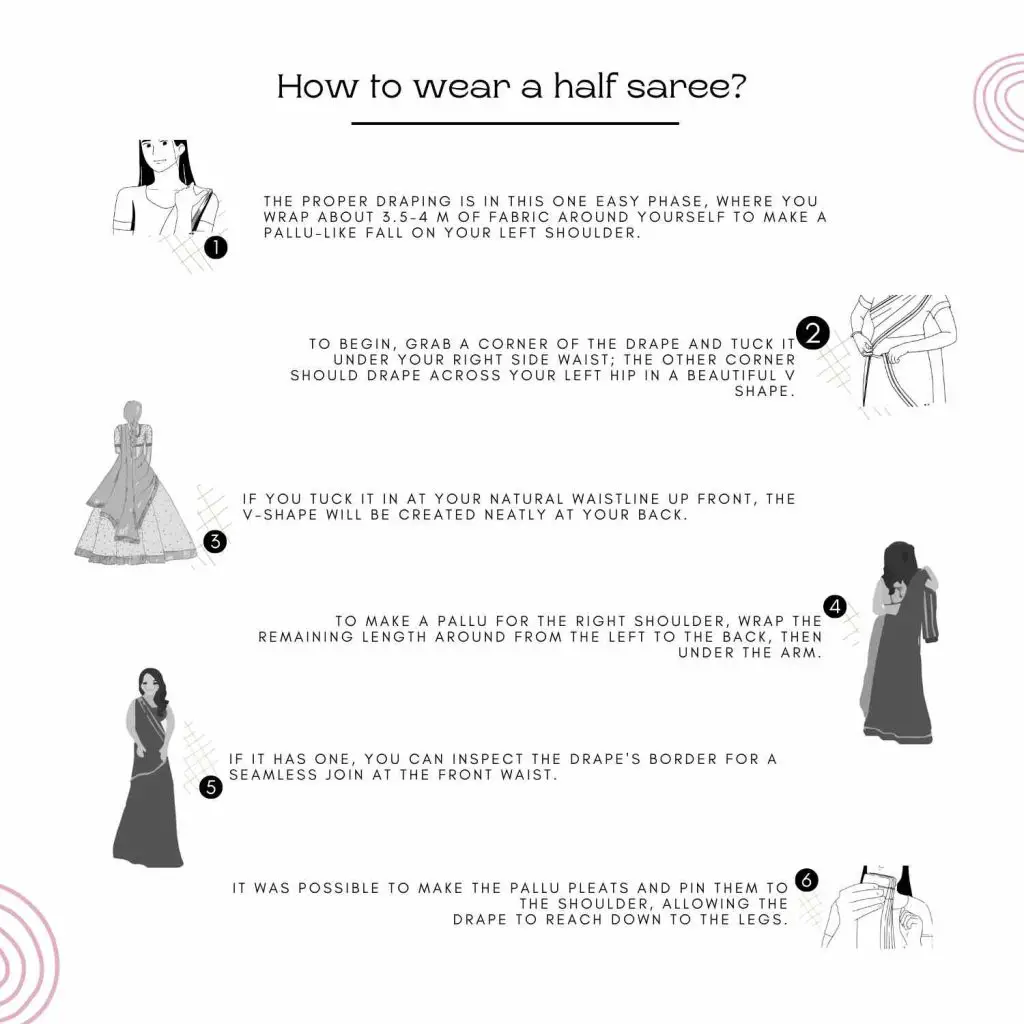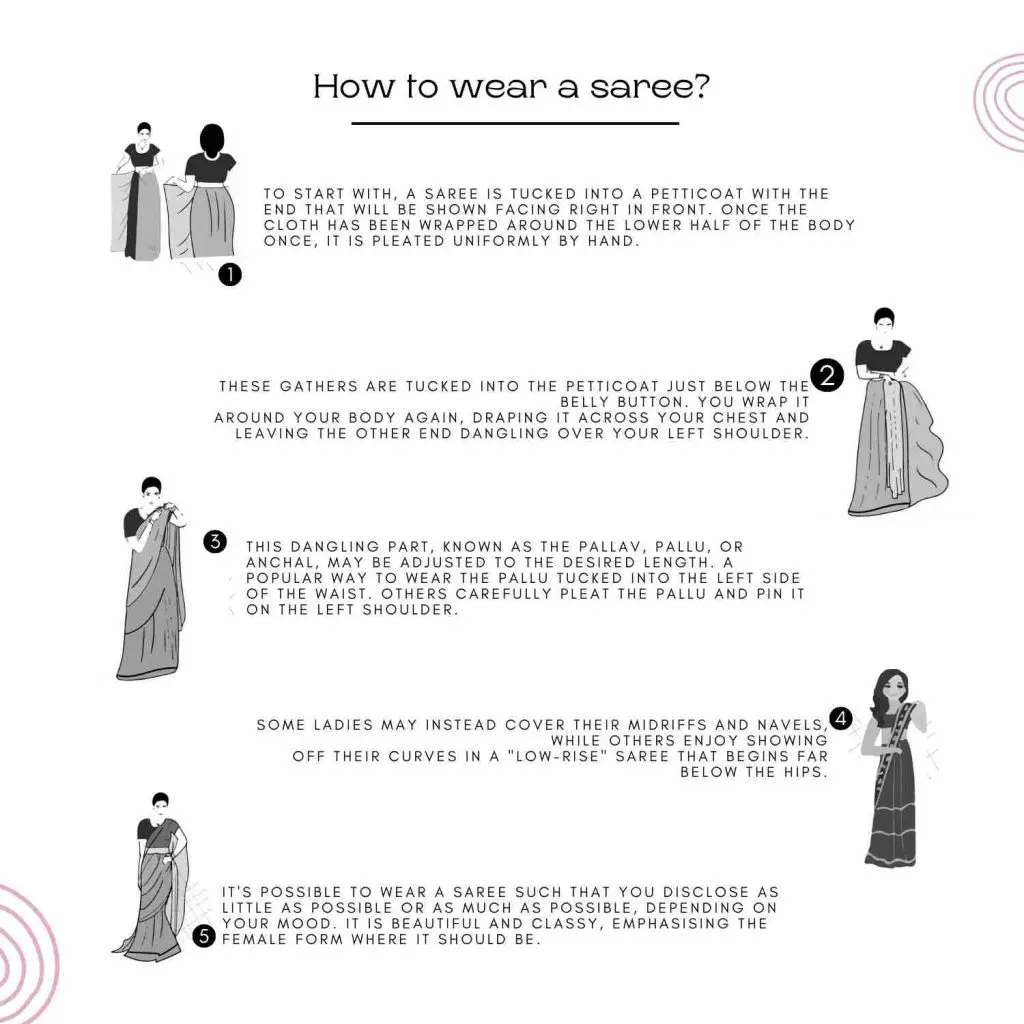The traditional clothing of India has long been an essential element of the country’s legacy and has gained international acclaim. The saree is a timeless piece of conventional clothing cherished by women of all ages and backgrounds.
The full saree and the half saree are two of the most common variations of the traditional Indian dress. Somebody may wear both of these garments to a wide variety of formal and informal parties and situations with ease and grace.
However, there are a few key distinctions between the two. This article will examine the distinction between the half saree and the full saree.
HALF SAREE VS FULL SAREE
In South India, half sarees, or lehenga sarees, are a common form of traditional South Indian dress. The waist-cinched skirt and slung-over-one-shoulder dupatta leave the wearer’s other shoulder and stomach bare.
Traditional lengths for the skirt and the dupatta are at or below the ankles and the feet, respectively.
A full saree, on the other hand, is a more traditional and classic Indian garment which consists of an extended length of cloth wrapped around the body and nestled into the waistline.
In most cases, it envelops the wearer from head to toe, including the legs and the stomach. Typically, a saree is worn with a blouse to cover the full body and a petticoat to give the saree some more body and structure.
Half sarees were known to have been associated with a girl’s transition into a young woman, and thus being only 2-2.5 meters long.
Meanwhile, a full saree with 4.5-9 meters has been associated with comfort and elegance and has been around since the inception of the Indus valley civilisation.
WHAT IS A HALF SAREE?
The half saree, a traditional outfit worn by teenage girls, consists of a skirt, a blouse, and a material to be draped over the upper body.
The garment is most well-liked in southern India, which goes by the title langa voni or langa davani. Like the full-length kind, the half saree comes in various materials, hues, and patterns to suit any taste.
In order to help young girls make the jump from the simpler paavadai (skirt) sattai (blouse) of their youth to the more complex saree (drape) of adulthood, a half saree is sometimes worn.
HERITAGE AND SYMBOLIC MEANING OF HALF SAREE
Since most youngsters wear a more unadorned skirt and top, this costume was initially designed to ease the transition between the two.
After puberty, a woman may participate in a ceremony or rite of passage that signifies her readiness for marriage. This event serves as a symbolic passage into adulthood.
In this ritual, a woman’s maternal grandparents give her a half-finished saree. After the first portion of the event, her paternal grandparents give her an excellent saree to wear.
During the second portion of the ceremony, the bride puts on the saree, a highly significant gesture that foreshadows her impending maturity.
During a child’s naming ceremony, the maternal grandparents often present the infant with the first half of the saree as a gift. However, this is not the case everywhere throughout South India; it is localised to specific regions.
DESIGN AND CREATION OF HALF SAREE
When compared to full sarees, half sarees are made and designed similarly. New takes on the half saree have emerged due to developments in fashion and this garment’s design in recent years.
Machines sew fabrics together, and while some embroidery is done by hand, the machines do most of the labour to cut costs.
However, the half saree or half lehenga may be worn with various designs and patterns, unlike most traditional ethnic clothing.
Since silk (one of the most prized textiles in South India) or cotton is utilised in its construction, somebody can include virtually any theme or pattern in its design.
The voni, or pallu, of a saree, may be made with fabric of a different colour than the rest of the garment.
There is a strong resemblance between the half saree and the silk pavada, worn by younger girls. As opposed to the blouse of a half saree, which stops at the stomach, the latter reaches the waist and covers the whole midsection.
The langa or pavada, a type of ankle-length skirt gathered at the waist and secured with a string, is the bottom skirt-like garment. The top half of the ensemble is a blouse, much to what would be worn with a traditional saree.
HOW TO WEAR A HALF SAREE?
After donning the blouse and the skirt, just like with sarees, you should double-check that the two pieces complement each other in terms of style.
- The proper draping is in this one easy phase, where you wrap about 3.5–4 m of fabric around yourself to make a pallu–like fall on your left shoulder.
- To begin, grab a corner of the drape and tuck it under your right side waist; the other corner should drape across your left hip in a beautiful V shape.
- If you tuck it in at your natural waistline up front, the V-shape will be created neatly at your back.
- To make a pallu for the right shoulder, wrap the remaining length around from the left to the back, then under the arm.
- If it has one, you can inspect the drape’s border for a seamless join at the front waist.
- It was possible to make the pallu pleats and pin them to the shoulder, allowing the drape to reach down to the legs.

RELEVANCE OF HALF SAREE IN THE CONTEMPORARY WORLD
The half sari has fallen out of favour as everyday wear due to the widespread adoption of the shalwar kameez and the general belief that it is cumbersome.
Modern “lengha-style sarees” have been influenced by the traditional langa voni, and the garment itself has made a resurgence.
However, the half saree has very recently gained appeal with young women as occasional wear. The once-plain garments now often feature ostentatious embellishments like zari work and daring hues traditionally thought unlucky.
Fabrics like chiffon, nylon etc., are utilised alongside traditional silk and cotton. Certain full saris are made with a colour or pattern shift at the hip to create the illusion of a half saree.
WHAT IS A FULL SAREE?
A saree is a traditional Indian dress worn by women. It is made from a rectangular piece of cloth that ranges in size from 2 to 4 feet in width and 5 to 9 yards in length (60 cm to 1.20 m).
Across the Indian subcontinent, the saree is revered as a sign of elegance and sophistication.
Women in India often wear it with a petticoat and a form-fitting top known as a blouse. A blouse can be sewn from the leftover fabric at the saree’s finish or purchased separately.
Today, however, the term also encompasses fabrics that have been woven, either mechanically or by hand, and often have a uniform density throughout.
The name “saree” has also changed over time to encompass a wider range of modern fabrics, including cotton, silk, synthetic fibre, and others.
HERITAGE AND SYMBOLIC MEANING OF FULL SAREE
The saree’s ancestry may be traced back to the Indus Valley Civilization, which flourished between 2800 and 1800 B.C. A similar drape was used by priests during this period, as evidenced by historical records.
Poems and literature written in ancient Sanskrit and Tamil describe an Indian woman wearing a saree as radiant and graceful. There are spiritual associations with this garment as well.
With the arrival of foreigners years later, wealthy Indian ladies began commissioning artists to employ rare materials like precious stones and gold threads to create bespoke saris for the upper classes.
Nonetheless, the saree remained neutral as a garment and was altered uniquely by people of different social classes. That elegance of the outfit is still there.
As India’s textile industry flourished in the twentieth century, saree designers began incorporating decorative elements such as figures, patterns, and flowers.
As other countries increasingly influenced India, the saree emerged as the first global garment from India.
The saree is a sign of divinity in Indian culture and religion, and its wearer is seen as virtuous and powerful. Wearing a saree reminds Indian women of their cultural heritage and the importance of preserving their traditions.
DESIGN AND CREATION OF A FULL SAREE
There is a tale behind every saree’s pattern, and each one has its unique significance. The saree’s primary field is bordered on all four sides by elaborate patterns.
Two of these borders are along the saree length, while the third is at the saree’s end and is referred to as the Pallav.
The Pallav is an enlargement of the two longitudinal boundaries that intensify. The sari’s tassel is the portion slung over one shoulder and allowed to fall freely in front or rear.
If the two side borders include leafy vines, the pallav, or the last border, will have embroideries of a lush tree with many leaves and perhaps some flowers.
Although silk and cotton remain perennial favourites, sarees may now be found in various fabrics. Fabrics like georgette, chiffon, nylon, polyester, and so on are all used to make these popular synthetic versions of the traditional Indian saree.
Elegant chiffons and silk chiffons were staples in the wardrobe of Maharani Gayathri Devi, who essentially reinvented the saree’s design.
Furthermore, sarees are among the oldest continuously worn traditional clothing in any country and continue to be elegant. The saree’s pleats, drape, and placement on the body are the source of the look.
HOW TO WEAR A FULL SAREE?

- When worn, a saree is tucked into a petticoat with the end that will be shown facing right in front. Once the cloth has been wrapped around the lower half of the body once, it is pleated uniformly by hand.
- These gathers are tucked into the petticoat just below the belly button. You wrap it around your body again, draping it across your chest and leaving the other end dangling over your left shoulder.
- This dangling part, known as the Pallav, Pallu, or Anchal, may be adjusted to the desired length. A popular way to wear the Pallu is tucked into the left side of the waist. Others carefully pleat the Pallu and pin it on the left shoulder.
- Some ladies may instead cover their midriffs and navels, while others enjoy showing off their curves in a “low-rise” saree that begins far below the hips.
- It’s possible to wear a saree such that you disclose as little as possible or as much as possible, depending on your mood. It is beautiful and classy, emphasizing the female form where it should be.
Conclusion :
In conclusion, both the half saree and the full saree have their own advantages and disadvantages. The half saree is easier to wear and offers more flexibility in terms of style.
In contrast, the full saree is more elegant and traditional and offers more flexibility in terms of design. Ultimately, the choice between the two will depend on the occasion and personal preference.
Regardless of choice, both the half saree and the full saree are beautiful and traditional attire that continue to be popular in India and across the world.







